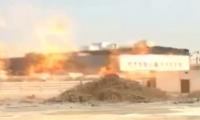A few questions first about the current Afghan situation, in order of their importance. Is Afghan peace hostage to big power rivalry? What policy should Pakistan adopt vis-a-vis various warring Afghan factions? Why have the Americans left without a viable power structure in Afghanistan and what is their future interest in the region? Is there a win-win formula for all as opposed to an ‘us versus them’ binary for major stakeholders in the peace and conflict equation? Is the US Afghan agenda being driven by realpolitik or the military industrial complex? If one starts with the last question first, the most evident reality would be the riling up of an upset military industrial complex.
The military industrial complex in the US is not happy about the closure of the Afghan project. The $500 billion Yemen bonanza that bilked Saudi Arabia and UAE of $400 and $100 billion each is also drawing to a close and a new war is not on the horizon. A technology-driven ‘over the horizon’ war would require the desired investments in capital to keep the war toy lobby happy, and assuage the domestic concerns about loss of American lives, in pursuit of nebulous war aims abroad. On the realpolitik front, this war from the distance would keep the pot boiling in Afghanistan, denying fruits of peace and stability to competitors like China.
Coming to the first question, it is a no brainer to see that the US-China rivalry is playing out in Afghanistan as well as South Asia. Countries like China and Russia have their own concerns regarding ingress of religious extremism in Xinjiang and the Central Asian Republics. The use of the Taliban by either of the protagonists against their adversaries will keep Afghanistan destabilized. Afghanistan will also remain destabilized if either of the global powers or regional countries starts supporting the rival factions. Another recipe for instability is the absence of a sustained aid regimen for the aid addicted economy of Afghanistan.
The answer to the question about the reasons for US departure would need a recap of the inconsistent US policies vis-a-vis Afghanistan over decades. The lack of a sustained and well-reasoned policy without clear strategic objectives was a weakness in American involvement according to ex NSA Lieutenant General McMaster and former Secretary Defence and Director CIA Leon Panetta. The disconnect between war and political aims was the most egregious flaw of the US civil and military leadership according to the two former members of the US establishment. Instead of having a long-term comprehensive Afghan stabilization strategy, the Americans followed a one-year war twenty times. Now the most interesting question is whether there is a win-win formula for all.
To answer the above question, one has to envision the ground realities and the national interests of three major power centers in Afghan conflict. The first is the present Afghan government that is interested in a power-sharing agreement in comport with the Afghan constitution as mandated by a Loya Jirga in 2019. The second – the Taliban – want an interim government with themselves in the lead role and other stakeholders as junior partners. The Taliban so far have presented a unified front while the Afghan government is a house divided against itself. Three influential members of governing coalition – Ustad Atta Muhammad Noor, Ustad Muhaqiq, and Abdullah Abdullah – do not see eye to eye with each other and neither with President Ashraf Ghani.
The ex-Northern Alliance warlords comprising the third power center like Ahmed Masood, Dostum, and Hikmatyar also do not support Ashraf Ghani and are ready to fight independently or enter into an alliance with the Taliban in return for some recompense. The common thread forming the interest skein for all, however, is a stake in the Afghan power pie. Now from the above it follows that any external power desirous of keeping the pot boiling would like to stoke the fires of conflict burning by arming the rival factions. US Secretary Defence ex General Lloyd Austin’s statement of providing military training, advisory, and monetary support to the Afghan National Defence and Security Forces (ANDSF) is portentous from the point of view of peace in Afghanistan.
It indicates that while the US is withdrawing, it is not removing Afghanistan from its crosshairs. The military industrial complex and the strategic community would push for an over the horizon counterterrorism engagement in Afghanistan. What is needed instead is international commitment to a negotiated end to conflict and for the economic stabilization of Afghanistan through sustained aid commitment. Instead of countering China through geopolitical sleight of hand, the US needs to embrace dominant global economic connectivity binding countries of strategic interest into ‘communities of cooperation’ through economic connectivity. The civil war does not redound to the advantage of Pakistan and other regional countries like Russia, China and Iran.
Pakistan needs to push for a win-win recipe of positive peace. The Taliban need to be convinced of the benefits of a negotiated power-sharing arrangement along with other power centers through the influence of regional countries. The US needs to resort to ‘over the horizon’ economic support to the future Afghan government in close collaboration with regional countries instead of over the horizon kinetic operations. It is only through these measures that the Afghan Taliban and other power brokers will see the value in burying the hatchet and smoking the peace pipe.
Though a leopard never changes its spots, it does adapt well to the new environment. The Afghan people’s war fatigue and the Taliban’s exposure to a new environment will hopefully have chastened them enough in seeing the value of peace. The world community should play at those strengths instead of letting it lapse back into anarchy.
The writer is a PhD scholar at Nust.
Email: rwjanj@hotmail.com
Critics argue that strategy is vague, but closer look indicates strategic alignment with global trends and national...
To defeat it, we must distrust bot-driven narratives, to defeat it, we must verify sources before believing or sharing
Too often in emerging markets, digital innovation is treated as standalone goal, with risk relegated to afterthought
As in Pakistan lawfare’s impact and prevalence are increasing, situation is turning murkier
Number of traditions are associated with Eid, such as new clothes and giving and receiving of cash gifts as Eidi
Internationally, there have been misleading theories propounded about so-called slowing of Chinese economy







